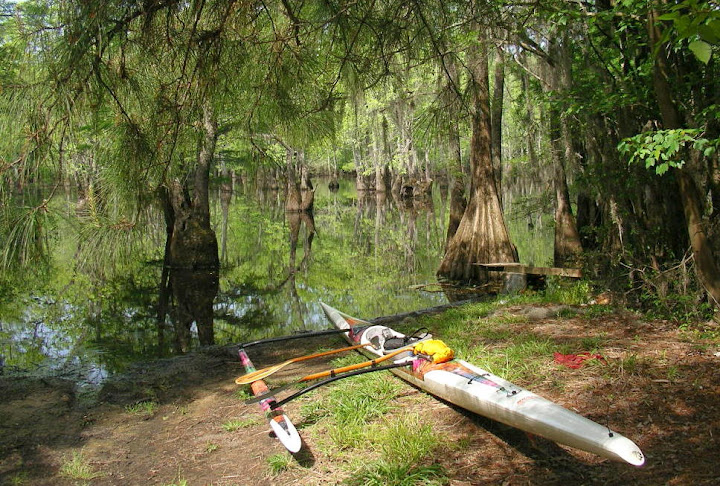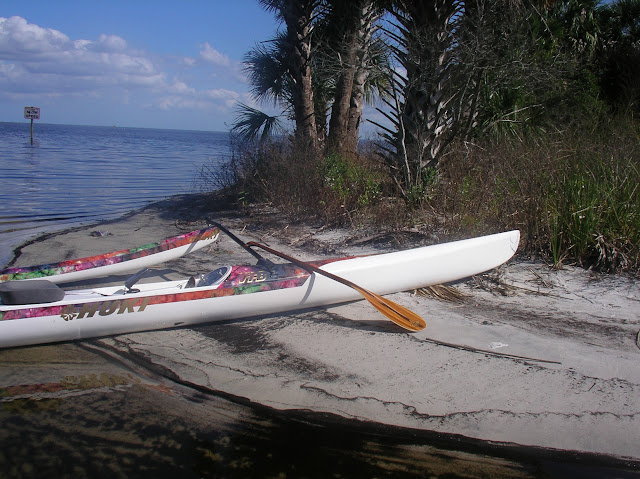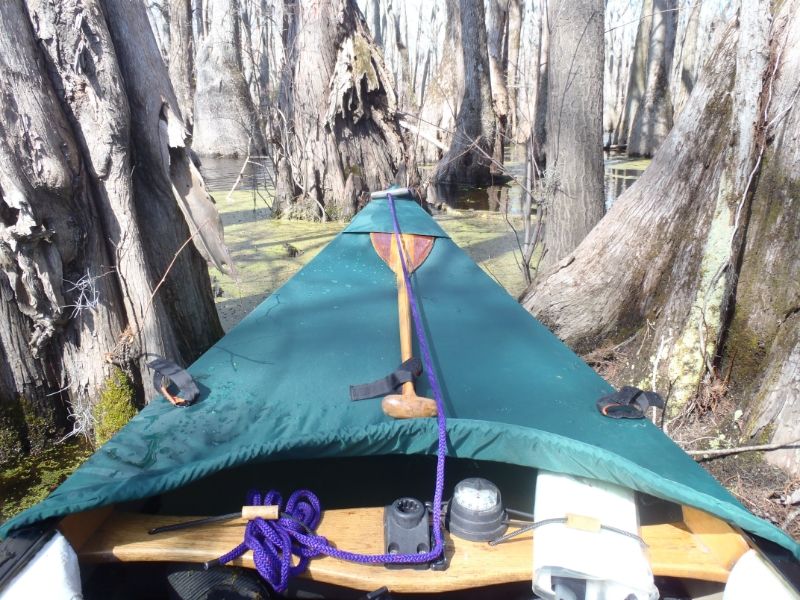A single person outrigger (va'a) takes the same amount of time to get on and off my van (the "magic bus") as any canoe or kayak. You do need a good distance between bars, as a va'a is 20'-22' long.

The "iakos" are the black aluminum bars that connect the main hull to the "ama" (the outrigger). In this picture you can also see my GPS mounted on the footwell wall in front of the seat, the spare paddle clips on the rear iako, and the 6" Beckson screw hatch in front of the footwell. There is another 6" hatch on the rear hull behind the foam seat.

In this picture you can see the GPS mount and front hatch better. You can stuff narrow things (ultralight hiker gear) into the entire front hull. So also the back hull, except there is a foam pillar there.

To car top, you disassemble the iakos, via simple push button clips, and substitute "stubby iakos" to bring the hulls close together. This takes 5 minutes. You can see stubby iakos in this picture from the Huki site. Huki also has an ingenious way of locking the hull on the rack via cable lock holes in the stubby iakos.

The Hawaiian OC1 takes up very little horizontal room when on the car top. Notice the massive rocker for ocean surfing, which I'll come back to later when discussing rudderless paddling.

You can see the stubby iako and ama better from this angle. You can also see that I have the main hull resting on those inexpensive foam cradles that you snap over the rack bars, which are commonly available. I don't think I even had to shape them. I've driven more than 20,000 miles with this boat on this rack system, including some very scary winds in Montana, and the boat has never shifted more than a few inches. Two straps; no bow or stern tie downs.

For straight ahead paddling in any wind or wave condition the va'a is unbeatable. You can paddle on either side with no correction needed. You can switch sides or stay on the same side the whole time. The foam seat slides fore and aft to accommodate different size legs. The water drains out of the footwells via venturi drains, though I usually plug them up.
The ama can be adjusted vertically via screws on the iakos -- meaning you can put more or less permanent "heel" toward the ama for stability. When you get really good and go fast, you can bring the hull level and "fly the ama" out of the water, risking capsize ("huli") to the non-ama side. You typically do this when surfing at 20 mph down the face of 15' ocean swells, but you can also do it with a little speed on flatwater.
Huki Jude, the owner of Huki, said I was the only paddler he had ever see fly the ama in his first five minutes on a va'a, when he took me for my initiation paddle on the American River in Sacramento. (Huki Jude didn't know that that then 59 year old guy used to surf class 4 waves in the Hudson gorge and Cheat canyon in skinny whitewater boats.)
Rudders come in different sizes. The one in these pictures is a 4" weedless flatwater rudder. I also have a 9" ocean surfing rudder. You can remove a rudder in 20 seconds. You can also paddle without a rudder. My Huki V1-B has massive rocker, and can actually turn not so horribly when the rudder is removed. I have done that to go up down twisty rivers with beaver dams and such.
This is a very good beaver dam boat. You just paddle up on the dam, stand up on the wood, and slide the va'a forward underneath your legs.
I have had it up to 8 mph on a lake in the Sierra Nevada mountains, but that was a 59 year old guy at 7600 foot altitude. A young, fit person could get over 10 mph easily on a sprint. The 11.8" water line beam and great speed makes a va'a a great boat for going upstream in current. The rudder allows you to ferry and change angles of attack easily without any paddle control needed.
I portaged it in the Boundary Waters and Adirondacks without even disassembling the iakos. I just put the main hull on my padded shoulder and walked with the the ama dangling by my knees.
My va'a was made with thicker carbon cloth and an extra layer of S glass on the bottom, so it's several pounds heavier than a racing model. The batik cloth inlays and the Beckson hatches also add a couple of pounds. So so my Tahoe Batiki weighs probably about 30-32 pounds assembled. Racing models can be 10 pounds lighter.
According to the Yellowstone park ranger who shot these pictures, I was the first outrigger paddler ever on the Lewis River in Yellowstone. I also hold the outrigger altitude record of 10,050 feet at Saddlebag Lake, California.


The "iakos" are the black aluminum bars that connect the main hull to the "ama" (the outrigger). In this picture you can also see my GPS mounted on the footwell wall in front of the seat, the spare paddle clips on the rear iako, and the 6" Beckson screw hatch in front of the footwell. There is another 6" hatch on the rear hull behind the foam seat.
In this picture you can see the GPS mount and front hatch better. You can stuff narrow things (ultralight hiker gear) into the entire front hull. So also the back hull, except there is a foam pillar there.
To car top, you disassemble the iakos, via simple push button clips, and substitute "stubby iakos" to bring the hulls close together. This takes 5 minutes. You can see stubby iakos in this picture from the Huki site. Huki also has an ingenious way of locking the hull on the rack via cable lock holes in the stubby iakos.

The Hawaiian OC1 takes up very little horizontal room when on the car top. Notice the massive rocker for ocean surfing, which I'll come back to later when discussing rudderless paddling.
You can see the stubby iako and ama better from this angle. You can also see that I have the main hull resting on those inexpensive foam cradles that you snap over the rack bars, which are commonly available. I don't think I even had to shape them. I've driven more than 20,000 miles with this boat on this rack system, including some very scary winds in Montana, and the boat has never shifted more than a few inches. Two straps; no bow or stern tie downs.
For straight ahead paddling in any wind or wave condition the va'a is unbeatable. You can paddle on either side with no correction needed. You can switch sides or stay on the same side the whole time. The foam seat slides fore and aft to accommodate different size legs. The water drains out of the footwells via venturi drains, though I usually plug them up.
The ama can be adjusted vertically via screws on the iakos -- meaning you can put more or less permanent "heel" toward the ama for stability. When you get really good and go fast, you can bring the hull level and "fly the ama" out of the water, risking capsize ("huli") to the non-ama side. You typically do this when surfing at 20 mph down the face of 15' ocean swells, but you can also do it with a little speed on flatwater.
Huki Jude, the owner of Huki, said I was the only paddler he had ever see fly the ama in his first five minutes on a va'a, when he took me for my initiation paddle on the American River in Sacramento. (Huki Jude didn't know that that then 59 year old guy used to surf class 4 waves in the Hudson gorge and Cheat canyon in skinny whitewater boats.)
Rudders come in different sizes. The one in these pictures is a 4" weedless flatwater rudder. I also have a 9" ocean surfing rudder. You can remove a rudder in 20 seconds. You can also paddle without a rudder. My Huki V1-B has massive rocker, and can actually turn not so horribly when the rudder is removed. I have done that to go up down twisty rivers with beaver dams and such.
This is a very good beaver dam boat. You just paddle up on the dam, stand up on the wood, and slide the va'a forward underneath your legs.
I have had it up to 8 mph on a lake in the Sierra Nevada mountains, but that was a 59 year old guy at 7600 foot altitude. A young, fit person could get over 10 mph easily on a sprint. The 11.8" water line beam and great speed makes a va'a a great boat for going upstream in current. The rudder allows you to ferry and change angles of attack easily without any paddle control needed.
I portaged it in the Boundary Waters and Adirondacks without even disassembling the iakos. I just put the main hull on my padded shoulder and walked with the the ama dangling by my knees.
My va'a was made with thicker carbon cloth and an extra layer of S glass on the bottom, so it's several pounds heavier than a racing model. The batik cloth inlays and the Beckson hatches also add a couple of pounds. So so my Tahoe Batiki weighs probably about 30-32 pounds assembled. Racing models can be 10 pounds lighter.
According to the Yellowstone park ranger who shot these pictures, I was the first outrigger paddler ever on the Lewis River in Yellowstone. I also hold the outrigger altitude record of 10,050 feet at Saddlebag Lake, California.



